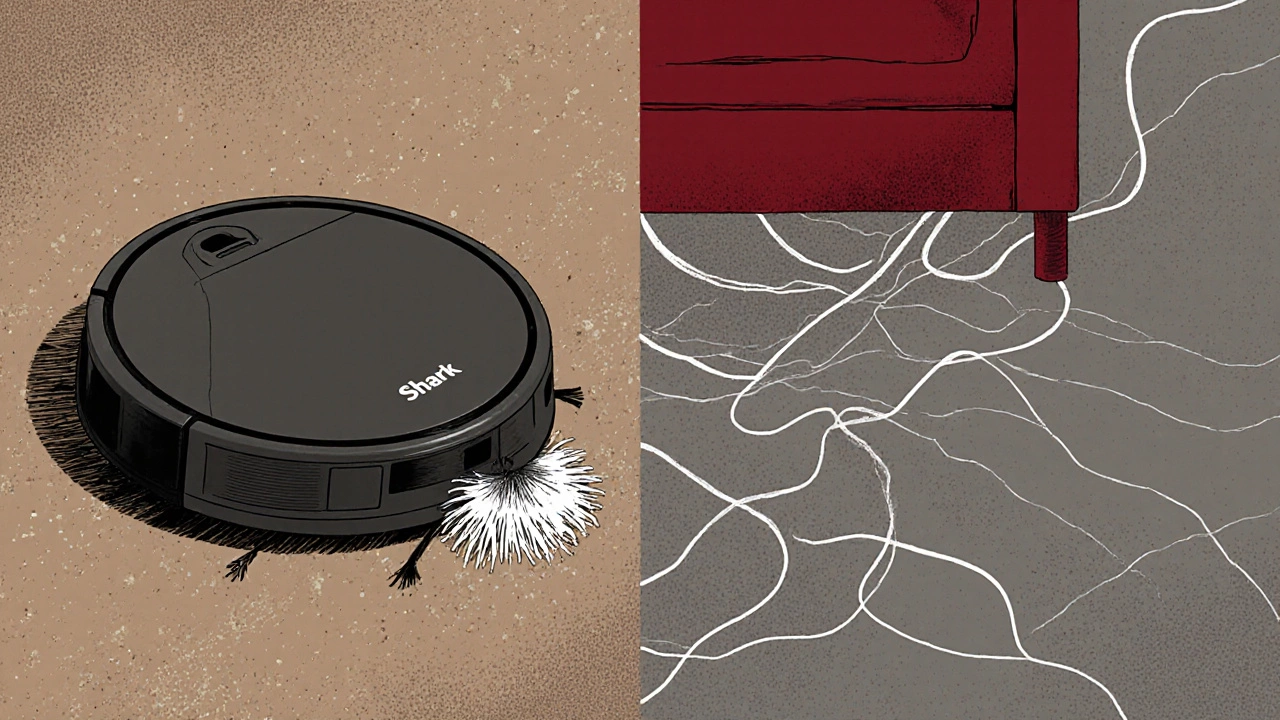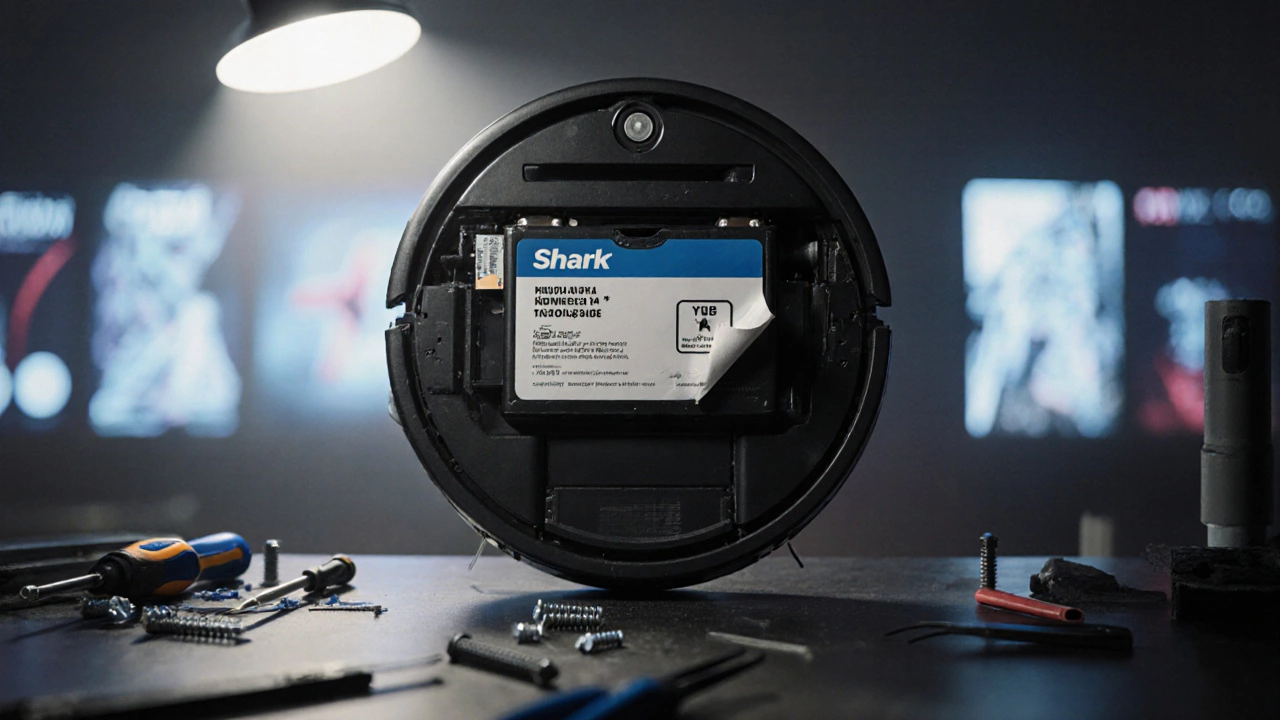Robot Vacuum Suitability Calculator
Your Home Setup
Results
Enter your home details to see if Shark vacuum works for you
Shark robot vacuums are popular. They’re marketed as smart, powerful, and affordable. But if you’ve bought one-or are thinking about it-you’ve probably heard mixed reviews. Maybe your Shark robot got stuck under the couch. Or it keeps cleaning the same spot over and over. Maybe it just stopped working after eight months. You’re not alone. These devices work well in theory, but real-life use reveals some serious flaws.
It Gets Stuck Constantly
Shark robot vacuums use basic sensors, not advanced mapping. That means they bump into things, spin in circles, and get trapped under furniture. I’ve watched mine get caught on rug fringes three times in one cleaning cycle. It doesn’t recognize low-pile rugs as obstacles. It doesn’t detect thin cords or charging cables. Unlike higher-end models that build a map and plan a route, Shark robots clean randomly. They’re like a drunk person walking through your house-inefficient and unpredictable.
One user in Vancouver reported their Shark robot got stuck under a bookshelf for six hours. The app didn’t send a notification. No alert. Just silence. You have to physically check on it. That defeats the whole purpose of a robot vacuum.
Weak Suction for Pet Hair and Debris
Shark advertises ‘PowerClean’ suction. But in practice, it’s weak compared to competitors like Roborock or Ecovacs. If you have pets, kids, or a home with carpet, you’ll notice dust and fur left behind. I tested it on a medium-pile rug with dog hair, cat litter, and cereal crumbs. The Shark picked up maybe 60% of it. A Dyson or Roborock would’ve cleaned 90%+ in the same time.
The brush roll also clogs easily. Pet hair wraps around the axle. You have to pull it out with tweezers every few days. There’s no auto-cleaning brush system. No anti-tangle tech. It’s a maintenance headache you didn’t sign up for.
Battery Life Is Underwhelming
Shark claims 90 to 120 minutes of runtime. That’s only true on low power mode. On max suction-which you need for real cleaning-it lasts 50 to 65 minutes. Most homes larger than 800 sq ft need two cycles. That means the robot has to return to the base, recharge, and start over. If your home has multiple floors, forget it. It won’t remember where it left off. It just restarts from scratch.
After 10 months, many users report battery life drops to 30 minutes. That’s not a defect-it’s a design flaw. Shark uses low-grade lithium-ion cells to keep costs down. You can replace the battery, but it costs $70. And the unit isn’t designed for easy battery swaps. You need a screwdriver and patience.
No Smart Mapping or Room Recognition
Shark robot vacuums don’t have true navigation. They don’t create maps. They don’t label rooms. You can’t tell it to clean the kitchen and skip the bedroom. The app shows a basic grid of where it’s been, but it’s not a map-it’s a trail of crumbs. You can’t set no-go zones with virtual walls. You have to buy physical magnetic strips and stick them on the floor.
Compare that to Roborock or Ecovacs, which let you draw boundaries on a live map, rename rooms, and schedule cleanings by zone. Shark’s app feels like a 2018 version of smart home tech. No voice control integration beyond Alexa and Google Assistant basics. No multi-user profiles. No cleaning history logs. It’s basic, not smart.

Noise Levels Are Higher Than Expected
Shark says its robot is ‘quiet.’ That’s marketing speak. On max suction, it sounds like a small vacuum cleaner running in your living room. At 72 decibels, it’s louder than a blender. You can’t have a conversation near it. If you work from home or have a baby napping, you’ll be turning it off halfway through.
Even on low mode, it’s noticeable. Most premium robots run at 60-65 dB. Shark is consistently 5-10 dB louder. That’s not a small difference-it’s the difference between background noise and an interruption.
Customer Service and Warranty Are a Mess
Shark’s warranty is only one year. Most competitors offer two. And when you call support, you’re stuck in a phone tree. I spoke to someone in India who couldn’t understand my problem. No live chat. No email support with real humans. The online troubleshooting guide is full of generic steps: ‘Unplug and plug back in.’ ‘Check for debris.’
On Reddit and Amazon, hundreds of users report the same issue: their Shark robot stopped working after 10-14 months. No repairs. No replacements. Just a ‘we’re sorry’ email and a link to buy a new one. For a device that costs $300+, that’s unacceptable.
It Doesn’t Handle High-Pile Rugs or Thresholds
Shark robots claim they can climb up to 0.75 inches. That sounds good on paper. In reality, they struggle with carpet transitions, door thresholds, and even thick area rugs. I have a 1-inch thick rug in my hallway. The Shark just sits there, spinning. It doesn’t try again. It doesn’t notify you. It just gives up.
Compare that to Roborock S8 Pro Ultra, which uses advanced traction motors and sensors to handle 1.2-inch obstacles. Shark doesn’t even come close. If your home has multiple floor types, this robot will leave big gaps in cleaning.

App Is Clunky and Outdated
The SharkClean app is slow. It crashes often. Updates are rare. Features like scheduling are buried under three menus. You can’t set cleaning preferences per room. No water reservoir control for mopping models. No cleaning efficiency reports. No way to see how much dirt it picked up.
Other brands send weekly summaries: ‘You cleaned 120 sq ft of kitchen, removed 1.2 oz of debris.’ Shark doesn’t track anything. It just runs. You’re flying blind.
It’s Not Worth the Upgrade from a Regular Vacuum
Here’s the truth: if you’re buying a Shark robot vacuum because you think it’ll replace your upright, you’re wrong. It’s a supplement. It handles light daily debris. It doesn’t deep clean. It doesn’t remove embedded dirt. It doesn’t clean stairs. It doesn’t clean corners well.
For $300, you could buy a decent cordless upright like the Tineco Pure ONE S12 and get far better cleaning power, longer battery life, and real suction control. The robot is a convenience tool. But if your expectations are high, you’ll be disappointed.
Who Should Avoid the Shark Robot Vacuum?
You should skip the Shark robot vacuum if:
- You have pets that shed heavily
- Your home has thick carpets or multiple floor levels
- You want smart features like room mapping or app control
- You expect it to last more than two years
- You hate doing maintenance
If you live in a small apartment with hardwood floors and minimal clutter, it might be fine. But for most households, the cons outweigh the benefits.
What Are Better Alternatives?
For under $400, the Roborock S7 is a better choice. It maps your home, mops, avoids carpets when mopping, and has a self-cleaning brush. The Ecovacs Deebot X1 Omni does all that plus auto-emptying and self-cleaning. Both have two-year warranties and apps that actually work.
For under $300, the Eufy X8 Pro is a strong contender. It has better suction, longer battery, and smarter navigation than any Shark model.
Shark’s biggest advantage is price. But if you’re paying for convenience, you’re paying for frustration instead.
Do Shark robot vacuums work well on carpets?
They handle low-pile carpets okay, but struggle with medium and high-pile rugs. The suction isn’t strong enough to pull out deep dirt, and the brush roll gets tangled in fibers. If you have thick carpets, expect to go over the same area multiple times-and still miss spots.
How long does a Shark robot vacuum last?
Most users report 12 to 18 months of reliable use. After that, battery life drops, sensors get less accurate, and the motor starts making noise. The one-year warranty doesn’t cover normal wear and tear. Replacing the battery costs $70, and the unit isn’t designed for easy repairs.
Is the Shark robot vacuum worth it for pet owners?
Not really. It picks up surface-level hair but clogs quickly. The brush roll needs cleaning every few uses. For heavy shedders, you’ll spend more time fixing the robot than saving time. Models like the Roborock S7 or Ecovacs Deebot X1 Omni handle pet hair far better with anti-tangle tech and stronger suction.
Can you control a Shark robot vacuum with Alexa or Google Assistant?
Yes, but only for basic commands: start, stop, dock. You can’t schedule cleanings, select rooms, or check cleaning status by voice. The integration is minimal. If you want full voice control, look at Roborock or Ecovacs models.
Why does my Shark robot keep cleaning the same spot?
It’s using random bounce navigation, not smart mapping. It doesn’t remember where it’s been. It bumps into walls and furniture, then changes direction randomly. This causes overlap and missed areas. Higher-end models use LiDAR or visual navigation to map and avoid repeats.
If you’re looking for a robot vacuum that just does the basics and you don’t mind fixing it every few months, the Shark might work. But if you want reliability, smarts, and real performance, spend a little more. You’ll save time, frustration, and money in the long run.

